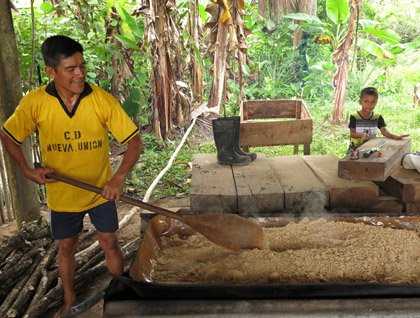The theme for today is rain. And this morning we saw firsthand where the rain forest gets its name. Minutes before our first scheduled outing a downpour began. And we decided that drinking a cup of coffee and listening to the sound of the rain from the lounge was a fine way to start the day. By definition, a rain forest needs to receive at least 100 inches of rain per year. This region receives a little more than that. On average 10 of those inches fall in March, so we knew that the blue skies of the last two days could not last all week.
By the time we finished breakfast, the rain had stopped and we boarded our skiffs for a visit to the village of Flor de Castaña. It is a pretty community that has an abundance of terra firme. It is somewhat unique among river communities in that you cannot see the community from the river edge. It is set back and hidden in the forest. This time of year we accessed the community by a narrow creek that only runs in the flooded season, so access was easy today (thank you, rain!). In the dry time of year it would take 30 minutes to walk to their village from the riverbank. The morning rain had freshened up the day and left it much cooler than the last two days. Very pleasant!
The visit to the village gave us the chance to have an up close view of people’s lives here. Kids came running across the soccer field (a central feature in the larger villages) to greet the skiffs. We strolled around town and saw the typical activities on a Wednesday morning. We watched one gentleman toasting cassava root, one of the staple foods here. To store it for later use is they grate it and toast it into a meal that is called fariña.
We then gathered with the children in the community center (it is still summer vacation here) and were treated to several songs. At the end of our visit they were given school supplies that many of us had brought from the United States.
This afternoon we explored the narrow and pretty Iracahua Caño. This is one of the creeks that is only accessible in the flooded season (thank you again, rain). In the dry season it is just a small creek. A highlight and prized bird for the afternoon was a rare sighting of a king vulture. This giant black and white vulture soared overhead, circling on the afternoon thermals. After that, my skiff spent our time concentrating on flowers and photographing them. The bright red passion flower first caught our eye. Then the water hyacinth, gustavia (relative of the Brazil nut) and a mimosa. Macro photography in a floating skiff was not the easiest of feats, but we tried anyway. Before we knew it, the afternoon was turning to night and we had to get back to the Delfin II.







